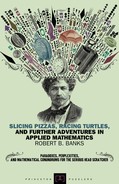Book Description
Have you ever daydreamed about digging a hole to the other side of the world? Robert Banks not only entertains such ideas but, better yet, he supplies the mathematical know-how to turn fantasies into problem-solving adventures. In this sequel to the popular Towing Icebergs, Falling Dominoes (Princeton, 1998), Banks presents another collection of puzzles for readers interested in sharpening their thinking and mathematical skills. The problems range from the wondrous to the eminently practical. In one chapter, the author helps us determine the total number of people who have lived on earth; in another, he shows how an understanding of mathematical curves can help a thrifty lover, armed with construction paper and scissors, keep expenses down on Valentine's Day.
In twenty-six chapters, Banks chooses topics that are fairly easy to analyze using relatively simple mathematics. The phenomena he describes are ones that we encounter in our daily lives or can visualize without much trouble. For example, how do you get the most pizza slices with the least number of cuts? To go from point A to point B in a downpour of rain, should you walk slowly, jog moderately, or run as fast as possible to get least wet? What is the length of the seam on a baseball? If all the ice in the world melted, what would happen to Florida, the Mississippi River, and Niagara Falls? Why do snowflakes have six sides?
Covering a broad range of fields, from geography and environmental studies to map- and flag-making, Banks uses basic algebra and geometry to solve problems. If famous scientists have also pondered these questions, the author shares the historical details with the reader. Designed to entertain and to stimulate thinking, this book can be read for sheer personal enjoyment.
Table of Contents
- Cover Page
- Title Page
- Copyright Page
- Dedication Page
- Contents
- Preface
- Acknowledgments
- Chapter 1 - Broad Stripes and Bright Stars
- Chapter 2 - More Stars, Honeycombs, and Snowflakes
- Chapter 3 - Slicing Things Like Pizzas and Watermelons
- Chapter 4 - Raindrops Keep Falling on My Head and Other Goodies
- Chapter 5 - Raindrops and Other Goodies Revisited
- Chapter 6 - Which Major Rivers Flow Uphill?
- Chapter 7 - A Brief Look at π, e, and Some Other Famous Numbers
- Chapter 8 - Another Look at Some Famous Numbers
- Chapter 9 - Great Number Sequences: Prime, Fibonacci, and Hailstone
- Chapter 10 - A Fast Way to Escape
- Chapter 11 - How to Get Anywhere in About Forty-Two Minutes
- Chapter 12 - How Fast Should You Run in the Rain?
- Chapter 13 - Great Turtle Races: Pursuit Curves
- Chapter 14 - More Great Turtle Races: Logarithmic Spirals
- Chapter 15 - How Many People Have Ever Lived?
- Chapter 16 - The Great Explosion of 2023
- Chapter 17 - How to Make Fairly Nice Valentines
- Chapter 18 - Somewhere Over the Rainbow
- Chapter 19 - Making Mathematical Mountains
- Chapter 20 - How to Make Mountains out of Molehills
- Chapter 21 - Moving Continents from Here to There
- Chapter 22 - Cartography: How to Flatten Spheres
- Chapter 23 - Growth and Spreading and Mathematical Analogies
- Chapter 24 - How Long Is the Seam on a Baseball?
- Chapter 25 - Baseball Seams, Pipe Connections, and World Travels
- Chapter 26 - Lengths, Areas, and Volumes of All Kinds of Shapes
- References
- Index
